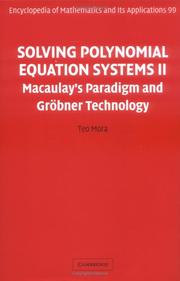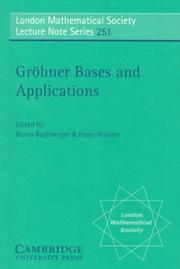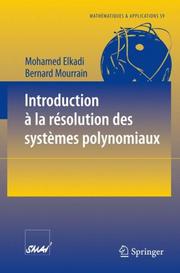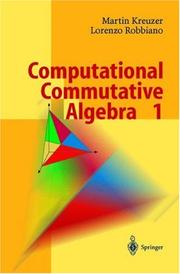| Listing 1 - 9 of 9 |
Sort by
|
Book
ISBN: 9814365149 9789814365147 1299671837 9781299671836 9789814365130 9814365130 Year: 2012 Publisher: New Jersey World Scientific
Abstract | Keywords | Export | Availability | Bookmark
 Loading...
Loading...Choose an application
- Reference Manager
- EndNote
- RefWorks (Direct export to RefWorks)
This monograph strives to introduce a solid foundation on the usage of Gröbner bases in ring theory by focusing on noncommutative associative algebras defined by relations over a field K. It also reveals the intrinsic structural properties of Gröbner bases, presents a constructive PBW theory in a quite extensive context and, along the routes built via the PBW theory, the book demonstrates novel methods of using Gröbner bases in determining and recognizing many more structural properties of algebras, such as the Gelfand-Kirillov dimension, Noetherianity, (semi-)primeness, PI-property, finitenes
Gröbner bases. --- Rings (Algebra) --- Gröbner basis theory --- Commutative algebra --- Algebraic rings --- Ring theory --- Algebraic fields --- Gröbner, Wolfgang, --- Gröbner, W.
Book

ISBN: 3110922754 9783110922752 9783110193237 311019323X Year: 2011 Publisher: Berlin Boston
Abstract | Keywords | Export | Availability | Bookmark
 Loading...
Loading...Choose an application
- Reference Manager
- EndNote
- RefWorks (Direct export to RefWorks)
This volume contains survey articles and original research papers, presenting the state of the art on applying the symbolic approach of Gröbner bases and related methods to differential and difference equations. The contributions are based on talks delivered at the Special Semester on Gröbner Bases and Related Methods hosted by the Johann Radon Institute of Computational and Applied Mathematics, Linz, Austria, in May 2006.
Gröbner bases --- Differential equations --- 517.91 Differential equations --- Gröbner basis theory --- Commutative algebra --- Kongress. --- Linz <2006> --- Algebras. --- base. --- ideal. --- polynomial. --- sybolic computation.

ISBN: 9781107340954 9780521811569 1107340950 9781107266902 1107266904 9781299707610 1299707610 9781107269989 1107269989 9780521811545 0521811546 0521811562 9780521811552 0521811554 1139883003 1107266556 110726443X 1107263344 1107267978 9781139015998 Year: 2005 Volume: v. 99 Publisher: Cambridge Cambridge University Press
Abstract | Keywords | Export | Availability | Bookmark
 Loading...
Loading...Choose an application
- Reference Manager
- EndNote
- RefWorks (Direct export to RefWorks)
The second volume of this comprehensive treatise focusses on Buchberger theory and its application to the algorithmic view of commutative algebra. In distinction to other works, the presentation here is based on the intrinsic linear algebra structure of Groebner bases, and thus elementary considerations lead easily to the state-of-the-art in issues of implementation. The same language describes the applications of Groebner technology to the central problems of commutative algebra. The book can be also used as a reference on elementary ideal theory and a source for the state-of-the-art in its algorithmization. Aiming to provide a complete survey on Groebner bases and their applications, the author also includes advanced aspects of Buchberger theory, such as the complexity of the algorithm, Galligo's theorem, the optimality of degrevlex, the Gianni-Kalkbrener theorem, the FGLM algorithm, and so on. Thus it will be essential for all workers in commutative algebra, computational algebra and algebraic geometry.
Equations --- Polynomials. --- Iterative methods (Mathematics) --- Iteration (Mathematics) --- Numerical analysis --- Algebra --- Numerical solutions. --- Graphic methods --- Gröbner bases. --- Gröbner basis theory --- Commutative algebra
Book
ISBN: 128066987X 9786613646804 9814383465 9789814383462 9814383457 9789814383455 Year: 2012 Publisher: Singapore : World Scientific Pub. Co.,
Abstract | Keywords | Export | Availability | Bookmark
 Loading...
Loading...Choose an application
- Reference Manager
- EndNote
- RefWorks (Direct export to RefWorks)
This volume consists of research papers and expository survey articles presented by the invited speakers of the conference on "Harmony of Gröbner Bases and the Modern Industrial Society". Topics include computational commutative algebra, algebraic statistics, algorithms of D-modules and combinatorics. This volume also provides current trends on Gröbner bases and will stimulate further development of many research areas surrounding Gröbner bases.
Gröbner bases --- Gröbner basis theory --- Commutative algebra --- Developed countries --- Advanced countries --- Advanced nations --- Developed nations --- Economically advanced countries --- Economically advanced nations --- First World --- Industrial countries --- Industrial nations --- Industrial societies --- Industrialized countries --- Industrialized nations --- Western countries
Book
ISBN: 311090974X 9783110909746 3110193337 9783110193336 Year: 2007 Publisher: Berlin New York Walter de Gruyter
Abstract | Keywords | Export | Availability | Bookmark
 Loading...
Loading...Choose an application
- Reference Manager
- EndNote
- RefWorks (Direct export to RefWorks)
This volume contains survey and original articles presenting the state of the art on the application of Gröbner bases in control theory and signal processing. The contributions are based on talks delivered at the Special Semester on Gröbner Bases and Related Methods at the Johann Radon Institute of Computational and Applied Mathematics (RICAM), Linz, Austria, in May 2006.
Gröbner bases. --- Control theory. --- Signal processing. --- Processing, Signal --- Information measurement --- Signal theory (Telecommunication) --- Dynamics --- Machine theory --- Gröbner basis theory --- Commutative algebra --- Algebras. --- base. --- control theory. --- signal theory. --- Grobner bases.

ISBN: 113988543X 1107365147 1107362695 1107367603 110737216X 1107369355 0511565844 9781107362697 9780511565847 0521632986 9780521632980 Year: 1998 Publisher: Cambridge, U.K. New York Cambridge University Press
Abstract | Keywords | Export | Availability | Bookmark
 Loading...
Loading...Choose an application
- Reference Manager
- EndNote
- RefWorks (Direct export to RefWorks)
This book provides an easy-to-read account of the theory of Gröbner bases and applications. It is in 2 parts, the first consists of tutorial lectures, and the second, 17 original research papers on Gröbner bases.
Gröbner bases. --- Coding theory --- Gröbner basis theory --- Commutative algebra --- Geometry, Algebraic --- Géométrie algébrique. --- Algorithms --- Algorithmes. --- Anneaux de polynômes. --- Polynomial rings. --- Algèbres commutatives. --- Polynômes --- Polynomials --- 512.56 --- 512.56 Lattices, including Boolean rings and algebras --- Lattices, including Boolean rings and algebras --- Grobner bases. --- Géométrie algébrique --- Algorithmes --- Anneaux de polynômes. --- Algèbres commutatives. --- Polynômes
Book
ISBN: 3540938052 9786612364532 1282364537 3540938060 Year: 2009 Publisher: Berlin : [Linz, Austria] : Springer ; RISC,
Abstract | Keywords | Export | Availability | Bookmark
 Loading...
Loading...Choose an application
- Reference Manager
- EndNote
- RefWorks (Direct export to RefWorks)
Coding theory and cryptography allow secure and reliable data transmission, which is at the heart of modern communication. Nowadays, it is hard to find an electronic device without some code inside. Gröbner bases have emerged as the main tool in computational algebra, permitting numerous applications, both in theoretical contexts and in practical situations. This book is the first book ever giving a comprehensive overview on the application of commutative algebra to coding theory and cryptography. For example, all important properties of algebraic/geometric coding systems (including encoding, construction, decoding, list decoding) are individually analysed, reporting all significant approaches appeared in the literature. Also, stream ciphers, PK cryptography, symmetric cryptography and Polly Cracker systems deserve each a separate chapter, where all the relevant literature is reported and compared. While many short notes hint at new exciting directions, the reader will find that all chapters fit nicely within a unified notation.
Coding theory. --- Cryptography. --- Gro ̈bner bases. --- Grèobner bases --- Coding theory --- Cryptography --- Mathematics --- Physical Sciences & Mathematics --- Algebra --- Gröbner bases. --- Gröbner basis theory --- Cryptanalysis --- Cryptology --- Secret writing --- Steganography --- Mathematics. --- Data encryption (Computer science). --- Computers. --- Computer science --- Algebra. --- Discrete mathematics. --- Combinatorics. --- Discrete Mathematics. --- Data Encryption. --- Mathematics of Computing. --- Theory of Computation. --- Commutative algebra --- Signs and symbols --- Symbolism --- Writing --- Ciphers --- Data encryption (Computer science) --- Data compression (Telecommunication) --- Digital electronics --- Information theory --- Machine theory --- Signal theory (Telecommunication) --- Computer programming --- Computer science. --- Information theory. --- Cryptology. --- Communication theory --- Communication --- Cybernetics --- Informatics --- Science --- Data encoding (Computer science) --- Encryption of data (Computer science) --- Computer security --- Combinatorics --- Mathematical analysis --- Computer science—Mathematics. --- Discrete mathematical structures --- Mathematical structures, Discrete --- Structures, Discrete mathematical --- Numerical analysis --- Automatic computers --- Automatic data processors --- Computer hardware --- Computing machines (Computers) --- Electronic brains --- Electronic calculating-machines --- Electronic computers --- Hardware, Computer --- Computer systems --- Calculators --- Cyberspace --- Grobner bases.

ISSN: 1154483X ISBN: 1281351598 9786611351595 3540716475 3540716467 Year: 2007 Volume: 59 Publisher: Berlin ; New York : Springer,
Abstract | Keywords | Export | Availability | Bookmark
 Loading...
Loading...Choose an application
- Reference Manager
- EndNote
- RefWorks (Direct export to RefWorks)
Les équations polynomiales apparaissent dans de nombreux domaines, pour modéliser des contraintes géométriques, des relations entre des grandeurs physiques, ou encore des propriétés satisfaites par certaines inconnues. Cet ouvrage est une introduction aux méthodes algébriques permettant de résoudre ce type d'équations. Nous montrons comment la géométrie des variétés algébriques définies par ces équations, leur dimension, leur degré, ou leurs composantes peuvent se déduire des propriétés des algèbres quotients correspondantes. Nous abordons pour cela des méthodes de la géométrie algébrique effective, telles que les bases de Grobner, la résolution par valeurs et vecteurs propres, les résultants, les bezoutiens, la dualité, les algèbres de Gorenstein et les résidus algébriques. Ces méthodes sont accompagnées d'algorithmes, d'exemples et d'exercices, illustrant leurs applications.
Gröbner bases. --- Polynomials. --- Computational complexity. --- Commutative algebra. --- Algebra --- Complexity, Computational --- Electronic data processing --- Machine theory --- Gröbner basis theory --- Commutative algebra --- Algebra. --- Computer science --- Geometry, algebraic. --- Numerical analysis. --- Commutative Rings and Algebras. --- Computational Mathematics and Numerical Analysis. --- Algebraic Geometry. --- Numerical Analysis. --- General Algebraic Systems. --- Mathematics. --- Mathematical analysis --- Algebraic geometry --- Geometry --- Computer mathematics --- Discrete mathematics --- Mathematics --- Commutative rings. --- Computer mathematics. --- Algebraic geometry. --- Rings (Algebra) --- Grobner bases.

ISBN: 354067733X 3540255273 3540706283 3642064914 3540282963 9783540677338 9783540255277 Year: 2005 Publisher: Berlin, Heidelberg : Springer Berlin Heidelberg : Imprint: Springer,
Abstract | Keywords | Export | Availability | Bookmark
 Loading...
Loading...Choose an application
- Reference Manager
- EndNote
- RefWorks (Direct export to RefWorks)
Computational Commutative Algebra 2 is the natural continuation of Computational Commutative Algebra 1 with some twists, starting with the differently coloured cover graphics. The first volume had 3 chapters, 20 sections, 44 tutorials, and some amusing quotes. Since bigger is better, this book contains 3 chapters filling almost twice as many pages, 23 sections (some as big as a whole chapter), and 55 tutorials (some as big as a whole section). The number of jokes and quotes has increased exponentially due to the little-known fact that a good mathematical joke is better than a dozen mediocre papers. The main part of this book is a breathtaking passeggiata through the computational domains of graded rings and modules and their Hilbert functions. Besides Gröbner bases, we encounter Hilbert bases, border bases, SAGBI bases, and even SuperG bases. The tutorials traverse areas ranging from algebraic geometry and combinatorics to photogrammetry, magic squares, coding theory, statistics, and automatic theorem proving. Whereas in the first volume gardening and chess playing were not treated, in this volume they are. This is a book for learning, teaching, reading, and most of all, enjoying the topic at hand. The theories it describes can be applied to anything from children's toys to oil production. If you buy it, probably one spot on your desk will be lost forever!
Gröbner bases --- Commutative algebra --- Grobner, Bases de --- Algebre commutative --- Data processing --- Informatique --- Commutative algebra -- Data processing. --- Gröbner bases. --- Gröbner basis theory --- Mathematics. --- Computer science --- Algebra. --- Algebraic geometry. --- Computer mathematics. --- Algorithms. --- Computational Mathematics and Numerical Analysis. --- Symbolic and Algebraic Manipulation. --- Algebraic Geometry. --- Data processing. --- Algebra --- Geometry, algebraic. --- Algebraic geometry --- Geometry --- Computer mathematics --- Discrete mathematics --- Electronic data processing --- Algorism --- Arithmetic --- Mathematics --- Mathematical analysis --- Foundations --- Combinatorial analysis. --- QA 150-272 Algebra. --- Computer science—Mathematics. --- Group theory. --- Group Theory and Generalizations. --- Groups, Theory of --- Substitutions (Mathematics) --- Commutative algebra - Data processing --- Algebre commutative - Informatique
| Listing 1 - 9 of 9 |
Sort by
|

 Search
Search Feedback
Feedback About UniCat
About UniCat  Help
Help News
News